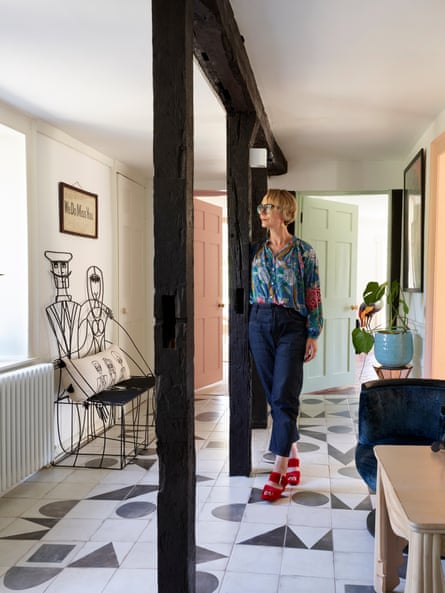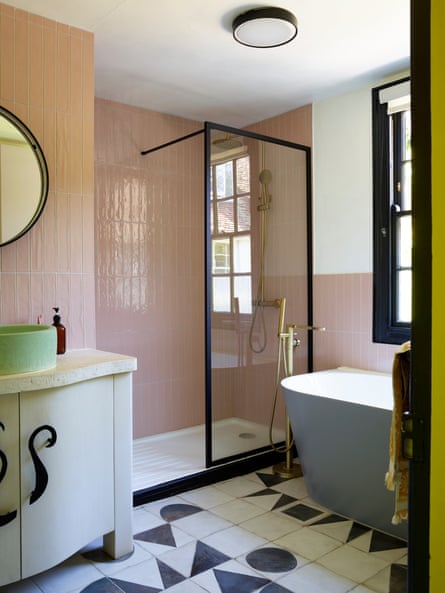
If there is one theme that will come to define early 21st-century interiors it’s nostalgia. Modernism, minimalism, maximalism – all these 20th-century “isms” have shaped the way we do up our homes in recent decades. Now, says Vicky Wetherill, a vintage dealer who likes to anticipate trends, it is time to embrace postmodernism: the experimental, exuberant design movement which had its heyday in the 1980s.
Wetherill’s own home in Hastings, East Sussex, where she lives with her husband and business partner, Jason Skriniar, pays homage to that era. Oversized furniture and objects, and woodwork picked out in a confection of ice-cream pastels and lacquered surfaces invoke the spirit of the age, without feeling retro. “It was a period of optimistic hedonism that produced some fantastic, playful pieces,” says Wetherill, whose clients include Chanel and Paloma Faith. “Postmodernism changed the boundaries of what was acceptable – but not in a vulgar way.”
The architecture of Wetherill’s home, in the old part of Hastings, could not be less postmodern. Behind its Georgian brick and stucco facade, the core of the listed building is Tudor. The apartment still has the original 16th-century beams; the elaborate carved fireplace is an 18th-century addition, but there are 20th-century echoes. The lofty proportions and soaring windows remind Wetherill of one those 80s Docklands warehouse conversions, with their sprawling open-plan spaces, first appreciated by film directors and photographers who could afford the square footage.
“The building is Grade II-listed and the planners wouldn’t allow us to make any drastic changes. So we’ve made the most of colour and pattern instead,” says Wetherill. They have pulled off 1980s chic on a budget. In the kitchen, for instance, the old country pine units were sold to pay for the smooth, white Ikea cabinets, “pimped” with new handles from Swedish brand Superfront, and deep quartz worktops. The marbled sideboard with its lacquered surface is another postmodern detail. The dining table is by Terence Conran.

The graphic effect is echoed in the bathroom. The handmade peppermint green basin was found on Etsy. A bow-fronted vanity unit was converted from a 1980s cabinet. Its original swirling handles exude optimism. In the next-door bedroom, crowned by a canopy of beams, the former art student rolled up her sleeves to paint a mural using old tester pots.
Wetherill grew up in Yorkshire, where her mother ran an antiques shop. “She sold traditional things: Arts & Crafts dressers, Spode mugs, rugs. We’d go to auctions together.” What Wetherill enjoyed most was rummaging through markets for vintage clothes, which she sold in her mother’s shop. Moving to Hastings from London turned her shopkeeper once more. “It’s a place that encourages you to do your own thing.”
And it is the furniture and objects in the apartment that really steal your attention. Postmodernism grew out of the Memphis Milano, the design collective founded by Italian architect Ettore Sottsass, which launched at Milan’s Salone in 1981. Memphis was particularly popular in the US, where its sculptural designs trickled down to mass-market manufacturers. “The midpriced designs were far more adventurous than their UK counterparts,” says Wetherill. “Practical pieces were made in unconventional colours, like pink and green.”

Every few months, the couple hire a van and head off on an American roadtrip, scouring auction rooms and estate clearances. Bringing her finds back is “a logistical headache” – which is why she is one of only a handful of dealers specialising in this area. But the venture is paying off. “The first piece I found was a pair of sculptural Vladimir Kagan lounge chairs. They were so different from the midcentury stuff we’d been buying until then. The furniture-dealer friend we were travelling with ridiculed us for buying them, but they sold straight away.”
There are some discoveries, however, from which Wetherill will not be parted: a tasselled table by Phyllis Morris. A giant daffodil lamp by Peter Bliss. A bench, in the form of a companionable couple, by John Risley. “I challenge you to find more interesting, and unusual pieces.”



